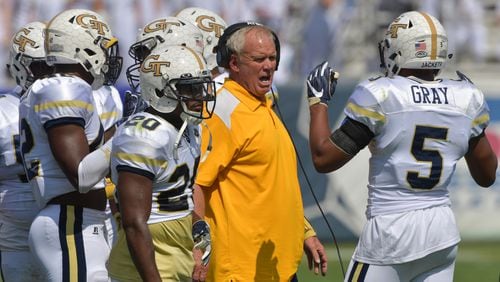As expected after Georgia Tech gave up nearly half of its points in the final minute of each half, the two-minute defense has been a major topic of discussion all week after a 25-24 loss to Miami on Saturday.
The Hurricanes marched 77 yards in nine plays -- taking just 1:47 -- at the end of the first half. They scored with 12 seconds remaining to make the score 14-13 in favor of Tech after the Yellow Jackets had controlled most of the first two quarters.
Trailing by two points on the final drive, Miami ran 15 plays, faced just one third-down conversion, and went 85 yards in 2:26 to kick the game-winning field goal with four seconds left.
“We realize we haven’t been very good in that deal,” coach Paul Johnson said about the two-minute defense. “We talked about it again this morning and went through some more scenarios and some stuff. But you’re not going to reinvent the wheel. You try to put in a package and you go play. We’re not the first team that’s happened to. I think it happened the week before against Florida State.”
The issue for Tech so far is that’s happened too often. The defense has faced seven meaningful end-of-half possessions this season -- with the second halves of the three wins being garbage-time drives. Against Tennessee, the Jackets held the Volunteers scoreless on the end-of-first half drive. The second-half drive wasn’t exactly a two-minute offense, but they went 93 yards in just seven plays to score a touchdown and tie the score with 1:29 left.
Jacksonville State moved the ball into Tech territory at the end of the first half, but elected not to try a long field goal and ran the clock out.
In a then-close game against Pittsburgh, the Tech defense allowed the Panthers to go 38 yards in 47 seconds and kick a 55-yard field goal as time expired to cut the lead to 21-17 at halftime. Ben Dinucci threw for 22 yards on two plays in a game in which he passed for just 110 yards.
North Carolina also had a field-goal attempt at the end of the first half. Taking over with 1:08 remaining, the Tar Heels went 40 yards in 12 plays, but missed the 52-yard field-goal attempt to conserve the shutout at the time.
The most successful end-of-half defensive drive for Tech still remains when Tennessee went 23 yards in six plays and turned the ball over on downs. The next best is Jacksonville State’s five-play, 38-yard drive that ended with the clock running out. For a defense that ranks fourth in the country in first-down rate -- which is the percentage of drives in which the opposing offense gains at least a first down or touchdown -- the inability to make stops in the two-minute defense is puzzling.
Tech defenders didn’t get into much detail when describing what changes were being made.
“Just execution,” Anree Saint-Amour said. “Just executing the plays better and getting to the ball better and not missing any tackles. Just finishing it off.”
“They were just executing what they were running,” Lawrence Austin said. “As players, we didn’t do a good job of doing what we needed to do … just getting our eyes and feet better and focusing on what we have to do.”
Tech is a bit of an outlier on the first-down rate stat. Six of the other nine teams in the top 10 are also in the top 10 in overall defensive efficiency according to Football Outsiders. The problem is teams are scoring a touchdown 36 percent of the time it gains one first down against the Jackets
“Bottom line is, if you don’t stop guys, it doesn’t work,” Johnson said. “The key to any kind of two-minute offense or one-minute offense is getting started. Once you make a first down or two and you get some momentum, then it becomes more difficult. We’ve got to try to create some more negative plays and we’ve got to try to play tighter.”
Tech ranks 124th in the nation in stuff percentage, which is the rate in which the opposing running back is stopped at or before the line of scrimmage. Only four teams have been worse.
Despite the end-of-half issues, the Jackets have still been an above-average unit as a whole defensively, ranking somewhere in the 30’s among most overall defensive stats. A couple plays resulting differently would likely have them looking much better through five games.
“I think clearly we’ve played better on defense than probably the last couple years,” Johnson said. But that’s not the goal. We want to be even better. We’ve played some really good games on defense and some games that weren’t good. Just like on offense. We didn’t exactly light it up in the second half on offense either. I can look at the tape and I can tell you what I think happened, but if I do, it’ll be because I’m making excuses, so I’ll just let you all figure it out.”
At the end of the day, Johnson keeps it pretty simple.
“Old guy, wise guy told me one time … it’s been pretty true. Every Saturday, 50 percent of the teams will win, and 50 percent will lose. It’s just kind of the way it works.”
About the Author






